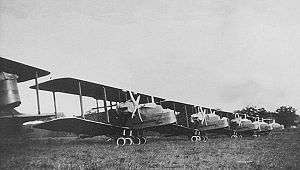Handley Page Hyderabad
The Handley Page H.P.24 Hyderabad was a British twin-engine biplane heavy bomber built by Handley Page which served with the Royal Air Force between 1925 and 1933. It was the last wooden heavy bomber to serve with the RAF.
| Hyderabad | |
|---|---|
 | |
| Role | Heavy bomber |
| Manufacturer | Handley Page |
| First flight | 23 October 1923 |
| Introduction | 1925 |
| Retired | 1933 |
| Primary user | Royal Air Force |
| Number built | 39[lower-alpha 1] |
| Developed from | Handley Page W.8 |
| Variants | Handley Page Hinaidi |
Design and development
The Hyderabad was a development of the Handley Page W.8 airliner, initially designated the W.8D, to meet Air Ministry Specification 31/22 for a replacement for the Vickers Vimy for the Royal Air Force.[2]
The Hyderabad was structurally similar to the W.8, and was an all-wooden, three-bay biplane powered by two Napier Lion engines. It was fitted with a single fin and rudder, and was one of the first large aircraft to be fitted with Handley Page leading edge slats, giving good lateral stability.[3]
A single prototype W.8D was ordered by the Air Ministry in January 1923, first flying in October 1923 and was delivered to the Aeroplane and Armament Experimental Establishment (A & AEE) at Martlesham Heath for evaluation against the Vickers Virginia.[2] On the basis of this evaluation, the aircraft, now called the Hyderabad, was ordered for use by the RAF.[2]
Operational history
The Hyderabad entered service with No. 99 (Bomber) Squadron RAF at RAF Bircham Newton in December 1925,[2] replacing the single-engined Avro Aldershot bomber.[3] Deliveries were slow, and accidental losses were high, with a second squadron, No. 10 Squadron RAF at RAF Upper Heyford only forming in 1928.[3] In 1928 and 1929, two Special Reserve squadrons were formed, receiving the Hyderabad as equipment. The two regular squadrons were re-equipped with the Handley Page Hinaidi, an all-metal development of the Hyderabad in 1931, while the final reserve Squadron, No 503, continued with the Hyderabad in service until 1933.[2]
Operators
Specifications (Hyderabad)
Data from The British Bomber since 1914 [2]
General characteristics
- Crew: 4
- Length: 59 ft 2 in (18.03 m)
- Wingspan: 75 ft 0 in (22.86 m)
- Height: 16 ft 9 in (5.11 m)
- Wing area: 1,471 sq ft (136.7 m2)
- Empty weight: 8,910 lb (4,042 kg)
- Gross weight: 13,590 lb (6,164 kg)
- Powerplant: 2 × Napier Lion V or VA W-12 water-cooled piston engine, 500 hp (370 kW) each at 2,250 rpm
- Propellers: 4-bladed fixed-pitch propellers
Performance
- Maximum speed: 109 mph (175 km/h, 95 kn)
- Range: 500 mi (800 km, 430 nmi)
- Service ceiling: 14,000 ft (4,300 m)
- Rate of climb: 800 ft/min (4.1 m/s)
- Wing loading: 9.24 lb/sq ft (45.1 kg/m2)
- Power/mass: 0.074 hp/lb (0.122 kW/kg)
Armament
- Guns: 3 × .303 in (7.7 mm) Lewis Guns in nose, dorsal and ventral positions
- Bombs: 1,100 lb (499 kg) bombs carried externally
See also
Related development
- Handley Page W.8
- Handley Page Hinaidi
- Handley Page Clive
Aircraft of comparable role, configuration and era
Related lists
Notes
- Original order was 44 plus prototype but a number of Hyderabads were completed as Hinaidis and others converted[1]
References
- Thetford 1976, pp. 283-285
- Mason, Francis K (1994), The British Bomber since 1914, London: Putnam Aeronautical Books, pp. 152–154, ISBN 0-85177-861-5
- Thetford, Owen (1957), Aircraft of the Royal Air Force 1918-57 (1st ed.), London: Putnam, pp. 242–243
Bibliography
- Barnes, C. H. Handley Page Aircraft Since 1907. London: Putnam & Company, Ltd., 1987. ISBN 0-85177-803-8.
- Clayton, Donald C. Handley Page, an Aircraft Album. Shepperton, Surrey, UK: Ian Allan Ltd., 1969. ISBN 0-7110-0094-8.
- Thetford, Owen. Aircraft of the Royal Air Force since 1918.London: Putnam & Company. 1976 ISBN 0-370-10056-5
External links
| Wikimedia Commons has media related to Handley Page Hyderabad. |